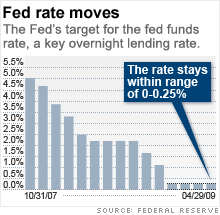Fed: Economy weak, but improving
Chairman Ben Bernanke and central bank keep rates steady near 0%. Says economy is still in decline, but the contraction has slowed.

NEW YORK (CNNMoney.com) -- The Federal Reserve said Wednesday that it believes the U.S. economy is getting worse, but the pace of decline has slowed and the outlook has improved.
The Fed's policy-making arm, the Federal Open Market Committee, also left interest rates unchanged in a range of 0% to 0.25% at the conclusion of its two-day meeting. Interest rates have been near zero since December.
"Household spending has shown signs of stabilizing but remains constrained by ongoing job losses, lower housing wealth and tight credit," said the FOMC in its statement.
The Fed noted that financial market conditions have improved "modestly," since last month, and said it expects inflation to "remain subdued."
"The policy-makers believe the actions taken by the central bank is bearing some fruit but the economy is still vulnerable," said Sung Sohn, economics professor at Cal State Channel Islands. "Despite the success, the central bank is concerned about over-optimism on the future course of the economy."
The Fed expressed more concern that inflation is too low -- falling prices could lead businesses to further cut their output and employment. For the second month in a row, the Fed said it sees some risk that the level of inflation could be lower than the Fed's target rate for some time.
Besides the improvement in the economic outlook, the statement was nearly identical to its March statement. Economists believe the Fed is purposely treading a thin line.
"The Fed realizes it's a tenuous situation that's bottoming, but Bernanke didn't want to do what [former Fed chief Paul] Volcker did and declare victory," said Doug Roberts, chief investment strategist of the Channel Capital Research Institute. "Declaring a bottom creates euphoria and an unsustainable [stock] rally, which can lead to a situation where the Fed would have to intervene again."
Stocks roared higher on the news then came back down to their prior levels. Bond prices edged lower. After its last meeting, the Fed announced it would buy $300 billion of long-term Treasurys through August in order to try and get credit flowing more freely again.
Some economists expected the Fed to announce more debt purchases, as bond prices have been declining on prospects of a recovery. Yields on the benchmark 10-year bond have risen back above 3% -- near the same level just prior to the Fed's announcement in March that it would be buying up government bonds. Bond prices and yields move in opposite direction.
The Fed has indicated it wants to keep yields lower in an attempt to keep borrowing costs down on loans whose interest rates are tied to Treasury yields. ![]()


